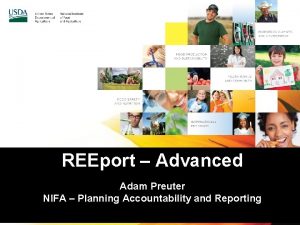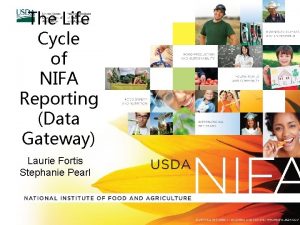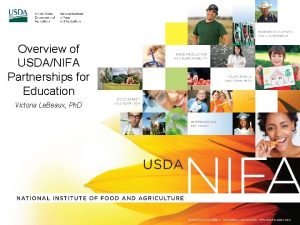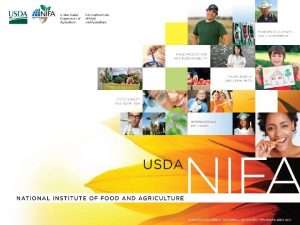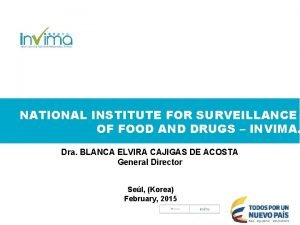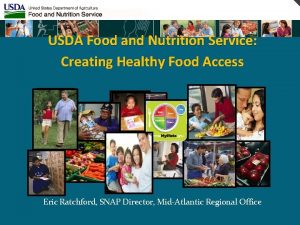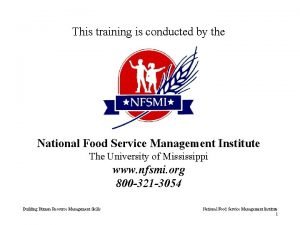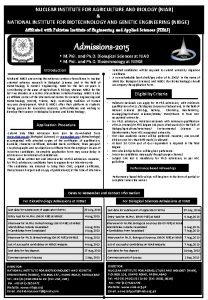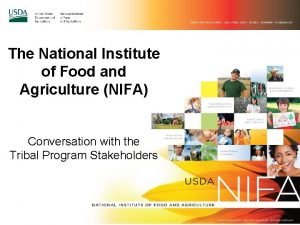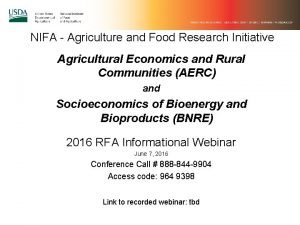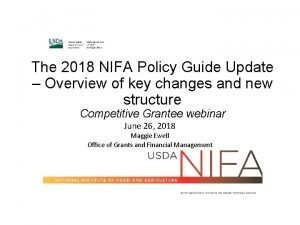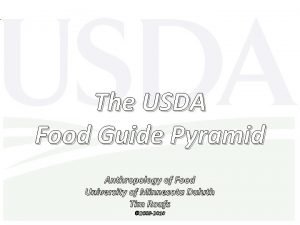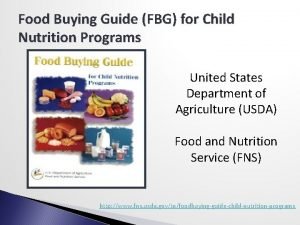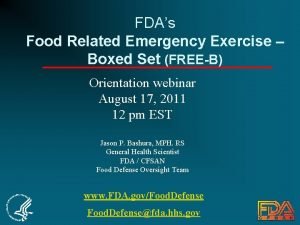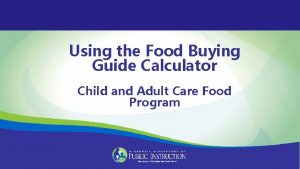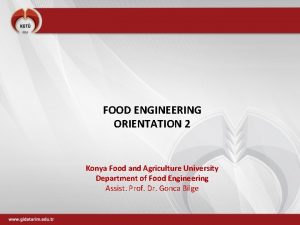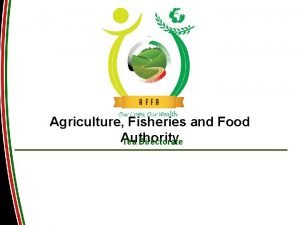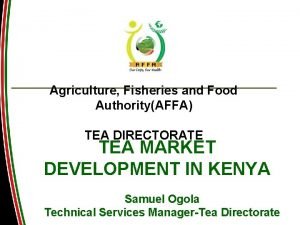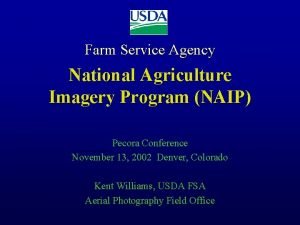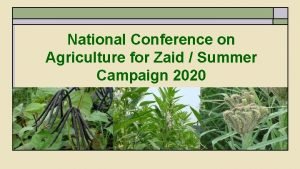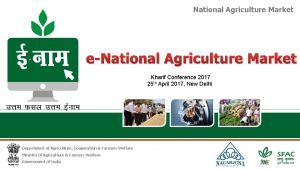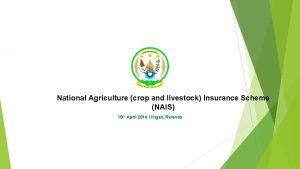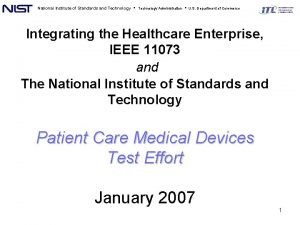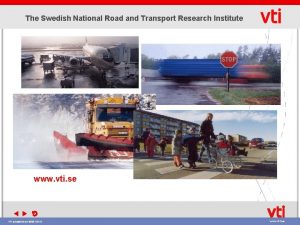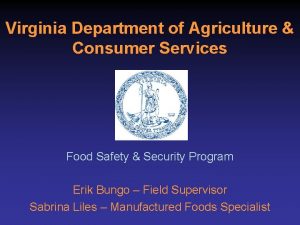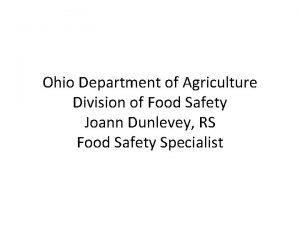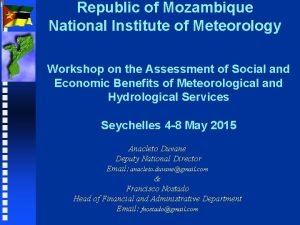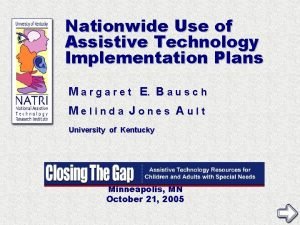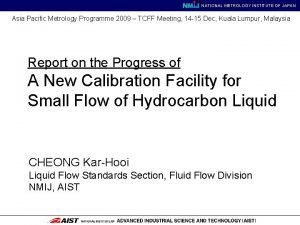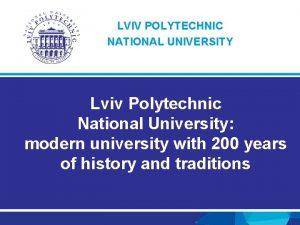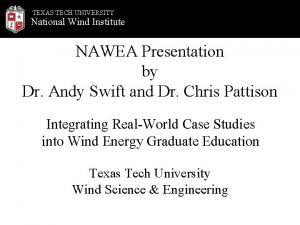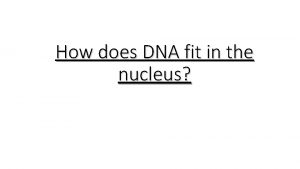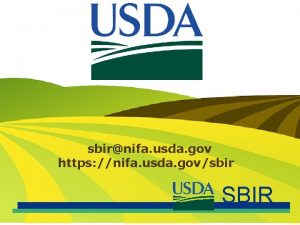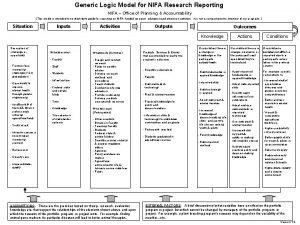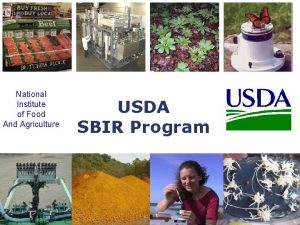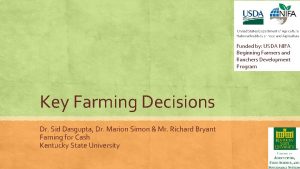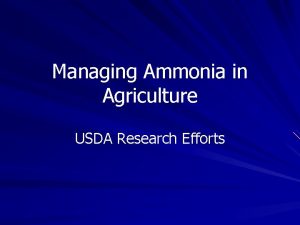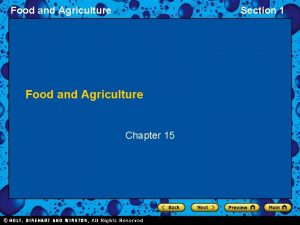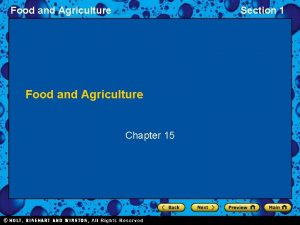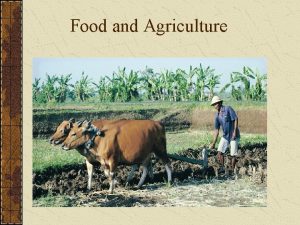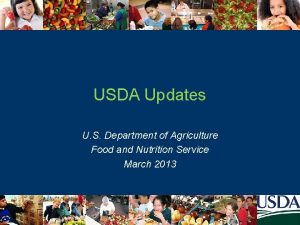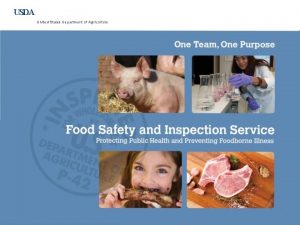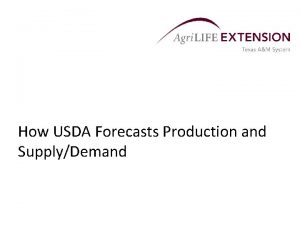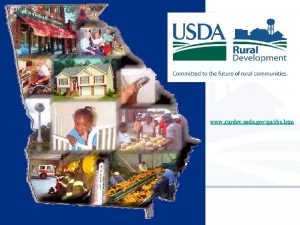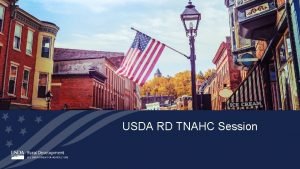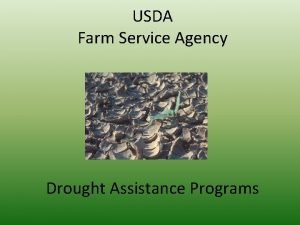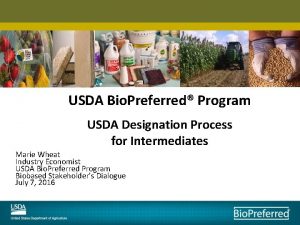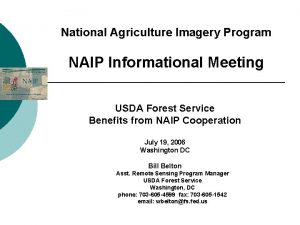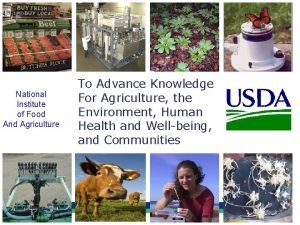USDA National Institute of Food and Agriculture NIFA








































- Slides: 40

USDA National Institute of Food and Agriculture (NIFA) EPSCo. R Overview Peter Johnson, DVM, Ph. D. NIFA EPSCo. R Management Team Member National Program Leader (Animal Health & Welfare) pjohnson@nifa. usda. gov

• Where does USDA EPSCo. R reside and how it is managed ?

National Institute of Food & Agriculture (NIFA: www. nifa. usda. gov) • USDA’s Extramural funding to advance food & agricultural research, education, & extension • Initiated October 1, 2009 • Preceded by Cooperative State, Research, Education, and Extension Service • FY 12 Budget = $1. 35 billion (research, education, & extension competitive & noncompetitive programs)

National Institute of Food & Agriculture • • • Office of the Director Institute of Food Production & Sustainability Institute of Bioenergy, Climate, & Environment Institute of Food Safety & Nutrition Institute of Youth, Family, & Community Office of Grants & Financial Management (award processing, etc. ) • Office of Information Technology

USDA-NIFA Cross-Institute & Office EPSCo. R Management Team Nancy Cavallaro & Bart Hewitt: co-leaders Gabrielle Armstrong Effie Baldwin Shawn Bennett Daniel Cassidy Erin Daly Peter Johnson Melanie Krizmanich Liang Shiou Lin Sharon Lumpkin Raymond Equal partners + Efficient use of limited NIFA administrative $$ which can not support staff dedicated only to EPSCo. R

• USDA-NIFA has many programs • EPSCo. R is part of the Agriculture and Food Research Initiative

Agriculture and Food Research Initiative (AFRI) (http: //www. nifa. usda. gov/funding/afri. html) • USDA’s largest competitive grants program FY 12 Budget = $264 million ($244 million payment to states) • Research, education, & extension projects • EPSCo. R is one component of AFRI (http: //www. nifa. usda. gov/funding/afri_fase_epscor_program. html )

AFRI • Wide Eligibility: 100% Research/ 100% Education/ 100% Extension: State Agricultural Experiment Stations, colleges, universities, university research foundations, other research institutions & organizations, federal agencies, national laboratories, private organizations or corporations, individuals Integrated: Colleges, universities, 1994 Institutions, Hispanic-serving agricultural colleges and universities • Indirect costs: Currently Capped at 30% • Matching funds (generally only equipment/ waivers may also apply)

12 Funding Opportunities • Applicants (including individuals from EPSCo. R states) have 12 request for applications (RFAs) to consider to fund their research, education, and/or extension programs : • 7 “in-house” RFAs • 5 interagency RFAs

Agriculture and Food Research Initiative Five Challenge Area RFA’s 1. 2. 3. 4. 5. Childhood Obesity Prevention Climate Variability & Change Food Security Food Safety Sustainable Bioenergy

Five Challenge Area RFAs • Often Inter/ trans-disciplinary • Most Integrated (research + education + extension) • Some Research or Education or Extension • FY 10 -12 Award Budget Range: $340, 000 - $45 million total (most multi-million dollars) • Up to 5 years duration

Agriculture and Food Research Initiative One Foundational Program RFA • Build a foundation of knowledge for solving current and future societal challenges • Only research funding opportunities (with one exception) • Maximum Award Budget = $500, 000 total ($350, 000 direct + $150, 000 indirects) • Up to 4 years duration

AFRI Foundational Program RFA includes 6 areas: 1. 2. 3. 4. Plant Health, Production & Plant Products Animal Health, Production & Animal Products Food Safety, Nutrition, & Health Renewable Energy, Natural Resources, & Environment 5. Agriculture Systems & Technology 6. Agriculture Economics & Rural Communities

Agriculture and Food Research Initiative One NIFA Fellowships Grant Program RFA 1. Offer individual fellowships for pre- and postdoctoral students – NIFA Fellows 2. Focus on the broad Challenge Areas, wide topic eligibility 2. 5% AFRI budget set-aside for pre- and post-doctoral proposals open to individuals at ALL institutions

• Predoctoral Fellowships: – $75, 000 (stipend, tuition, fees) – Research, education, or extension • Postdoctoral Fellowships: – $130, 000 (including institutional allowance) – Research, education, or extension – post Ph. D. , or D. V. M. , or M. D. degree

Agriculture and Food Research Initiative Interagency RFA’s: 1. Ecology and Evolution of Infectious Disease (USDA-NIFA; NIH; NSF; BBSRC) 2. Water Sustainability and Climate (USDA-NIFA; NSF) 3. Decadal and Regional Climate Prediction using Earth System Models (USDA-NIFA; NSF; DOE) 4. National Robotics Initiative (NIFA; NSF; NASA; NIH) 5. Plant Feedstock Genomics for Bioenergy (USDANIFA; DOE)

Proposal Options After applicants identify a specific RFA where their work fits, depending on where they are from and their career stage, different proposal options exist

AFRI Proposal types • Standard (research; education; extension; or, integrated) • Coordinated Agricultural Project (CAP) • Conference • Food & Agricultural Science Enhancement (FASE): (restricted eligibility= EPSCo. R bonus !) – Pre- and Postdoctoral Fellowships (1 program) – New Investigator – Strengthening

• New Investigator Awards (Less than 5 years postgraduate, career-track experience; No competitive Federal funds beyond pre- or postdoctoral grants or AFRI seed grants) – No specific RFA: identify AFRI program for their topic and submit to its deadlines – Proposal same as non-new investigator except box checked indicating eligibility – First compete with established investigators – No set-aside $$ but staff can use program dollars to support new investigator below funding line (forgo established investigator) Note: EPSCo. R or limited institutional success eligible have set-aside $$ to go below funding line (Bonus)

Strengthening Awards • 7. 5% AFRI budget set-aside for strengthening awards to: • EPSCo. R institutions • Small or mid-sized or minority-serving institutions with limited success for federal funding • FY 12 AFRI total budget = $244 million FY 12 total for strengthening = $ 18. 3 million

Strengthening Opportunities 1. Strengthening Standard proposal 2. Strengthening Coordinated Agricultural Project proposal • No specific RFA: identify AFRI program for topic and submit to its deadlines • Proposal same as standard proposal that everyone can submit except box checked indicating eligibility

Benefit of Set-aside $ to EPSCo. R institutions (2 funding chances in all programs) • Hypothetical Example: – 100 proposals – All institution proposals first compete against each other & ranked (including EPSCo. R) – Program funds can support top 10 submissions (non-EPSCo. R + EPSCo. R) – 7. 5% additional $$$ to support other meritorious EPSCo. R proposals below funding cut-off

More Strengthening Opportunities 3. Seed Grants 4. Sabbaticals 5. Equipment • No specific RFA: identify AFRI program for topic and submit to its deadlines • Each program evaluates all seeds, sabbaticals, equipment together

More Strengthening Opportunities: • Seed Grants ($150, 000 for 2 year duration) – Collect preliminary data for future AFRI funding • Sabbatical Grants – Up to one year of salary, funds for travel & supplies; also mini-sabbaticals • Equipment Grants: 50% of cost or $50, 000 for one piece of equipment ($10, 000 -250, 000); no IDC – Non-federal Matching, but waivers (<$25 K) for lowest one third institutions

Total EPSCo. R funding

Defining EPSCo. R States & Graduation • EPSCo. R program includes mechanism for graduation of states • When a state graduates, another state enters the program

EPSCo. R States – States having a funding level no higher than the 38 th percentile of all States based on a 3 -year rolling average of AFRI, excluding strengthening set-aside funds (19 states) • Since FY 09, NIFA re-assesses EPSCo. R eligible states annually • Prior to FY 09, EPSCo. R states were reassessed every 3 years and stayed constant for 3 year intervals

2012 EPSCo. R States: • • Alabama Alaska Connecticut Idaho Kentucky Maine Mississippi Montana • • • Vermont Nevada New Hampshire • West Virginia • Wyoming New Mexico North Dakota Oklahoma Rhode Island South Carolina South Dakota

Other USDA EPSCo. R eligible Entities: • • American Samoa District of Columbia Guam Micronesia Northern Mariana Islands Puerto Rico Virgin Islands of the U. S.

If a state “graduates” from EPSCo. R, its institutions may still qualify for strengthening if… 1) Small and mid-sized academic institutions with current total enrollment of 17, 500 or less, or Minority-serving institutions: enrollment of minorities exceeds 50 % 2) AND Limited institutional success: not among the most successful universities and colleges receiving federal funds for science and engineering. Examples: Montana State Univ. ; South Dakota State Univ.

Have EPSCo. R states graduated ? • • • Arkansas (2009) Connecticut (2006, but returned 2009) Delaware (2011) Hawaii (2012) Louisiana (2012) Mississippi (2006, but returned 2009)

Have EPSCo. R states graduated ? (cont. ) • • • New Hampshire (2006, but returned 2009) New Jersey (2009) New Mexico (2009, but returned 2011) Oklahoma (2009, but returned 2012) Rhode Island (2006, but returned 2009) South Dakota (2011, but returned 2012)

EPSCo. R States for the Last Ten Years 2003 Alabama Alaska Arkansas Connecticut Delaware Hawaii Idaho Kentucky Louisiana Maine Mississippi Montana Nevada New Hampshire New Jersey New Mexico North Dakota Oklahoma Rhode Island South Carolina South Dakota Vermont West Virginia Wyoming 2004 2005 2006 2007 2008 2009 2010 2011 2012

EPSCo. R Outreach • Two annual NIFA Competitive Programs Grantsmanship Workshops (includes EPSCo. R breakouts) • Webinars as requested by states to overview EPSCo. R opportunities • Workshops for Minority-Serving Institutions may include Strengthening Program overview (Hispanic; 1890; Alaskan/Pacific Islanders; Native American)

EPSCo. R Program Strengths • Graduation Criteria transparent & fair with no political influence • Apart from graduation, anecdotal evidence shows impact (EPSCo. R states receiving large Coordinated Agricultural Project awards; science advances; seed grants leading to larger research awards) • By having Strengthening set-aside (includes EPSCo. R) as % of AFRI budget, funding is guaranteed as long as AFRI has a budget

EPSCo. R Program Strengths • EPSCo. R dollars part of every AFRI review panel: – All agriculture & food science areas benefit each year – All AFRI National Program Leaders involved in, understand & support EPSCo. R science: • Optimum expertise for peer review • Integrated post-award management: – EPSCo. R awardees attend same annual project directors’ meetings as non-EPSCo. R awardees (no separation)

EPSCo. R Program Challenges • Collecting quantitative metrics for assessment: – Database limitations (Current Research Information System : http: //cris. csrees. usda. gov) with limited IT budget to upgrade/renovate – Does not aggregate/tabulate impacts (e. g. , publications; patents; students trained) – Does not distinguish EPSCo. R awards made from setaside vs. non-set aside funds – Does not request and update impacts after award termination

EPSCo. R Program Challenges • External Review Committees: – Review NIFA portfolios for impact (e. g. , Plant Systems; Animals; Natural Resources/Environment; Food Safety; Nutrition; Education…) – Focus is on portfolio as a whole (non-EPSCo. R + EPSCo. R together) • NIFA’s current administrative budget doesn’t allow targeted EPSCo. R program review

If we’ve done our job, for USDA EPSCo. R you now know … • • • Where it is found How EPSCo. R is managed The multiple EPSCo. R opportunities How EPSCo. R states are calculated & graduation Strengths Challenges

EPSCo. R THANK YOU…
 Usda nifa
Usda nifa Nifa data gateway
Nifa data gateway Usda nifa
Usda nifa Usda nifa
Usda nifa Regulatory agencies
Regulatory agencies Usda food and nutrition service
Usda food and nutrition service National food service management institute
National food service management institute Nuclear institute for agriculture and biology
Nuclear institute for agriculture and biology Ray ali usda
Ray ali usda Nifa in economics
Nifa in economics Nifa policy guide
Nifa policy guide Food groups pyramid
Food groups pyramid Usda food buying guide calculator
Usda food buying guide calculator Usda food pyramid 1970
Usda food pyramid 1970 Usda food defense self assessment checklist
Usda food defense self assessment checklist Food buying guide app
Food buying guide app Konya food and agriculture university
Konya food and agriculture university Tea directorate
Tea directorate Ministry of food agriculture and fisheries denmark
Ministry of food agriculture and fisheries denmark Tea directorate kenya
Tea directorate kenya National agriculture imagery program
National agriculture imagery program National conference on agriculture for summer campaign
National conference on agriculture for summer campaign Nmsa guidelines
Nmsa guidelines National agriculture market
National agriculture market National agriculture insurance scheme
National agriculture insurance scheme Unit 2 food food food
Unit 2 food food food Sequence of food chain
Sequence of food chain Unist application fee
Unist application fee National institute of standards and technology
National institute of standards and technology Swedish national road and transport research institute
Swedish national road and transport research institute Virginia department of agriculture food safety
Virginia department of agriculture food safety Ohio department of agriculture food safety
Ohio department of agriculture food safety Usda 3555 handbook
Usda 3555 handbook Mozambique national institute of meteorology
Mozambique national institute of meteorology National assistive technology research institute
National assistive technology research institute Toshiba 1b japanasia
Toshiba 1b japanasia Lviv polytechnic university
Lviv polytechnic university National wind institute
National wind institute National institute on drug abuse
National institute on drug abuse National human genome research institute
National human genome research institute National human genome research institute
National human genome research institute
